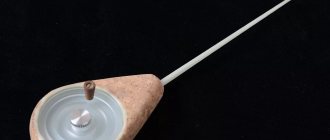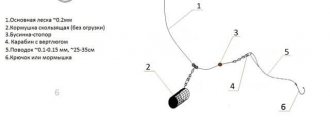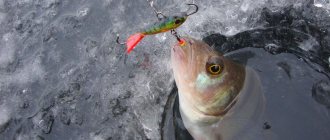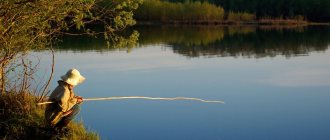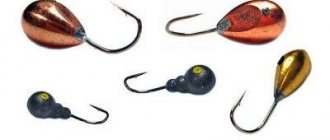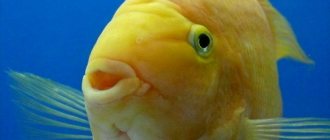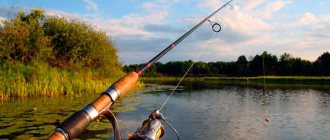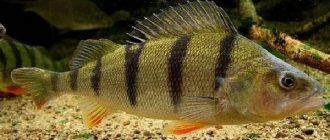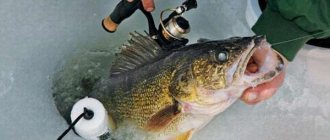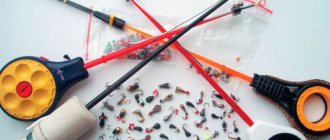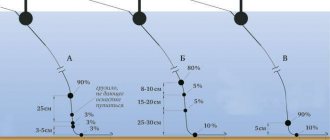The classic retrieve when fishing for perch in winter is a slow upward movement of the bait with frequent oscillations of the nod. This technique is also called dribbling. Usually the jig oscillates with short pauses of up to 5 seconds.
Winter fishing
The favorite pastime of every self-respecting fisherman in winter is catching perch with a jig. Many fishermen are specifically waiting for frosts so that they can quickly go through the first ice to their favorite body of water in order to try their new jigs there. Some jig fishers go to the depths to use large bait to catch a heavy croaker, while others are content with small “sailor fish” in shallow water, honing their skills in playing with a jig.
Perch loves an active, shaking, high-frequency game, often with tapping on the six of the fishing rod . When fishing with a jig with a bait, you should use bait responsibly. To attract perch, a feeding bloodworm or jig is suitable. If fishing involves working at relatively large depths, use feeders.
Catching perch in the middle of nowhere with a jig. Fish Search Tactics
Until the sun warms up and the first spring streams begin to gurgle, things will be difficult for our brother, the fisherman. Due to lack of oxygen, the fish refuses to actively bite. The January frosts are fierce, the February blizzard is - all the paths are covered with snow.
Many winter fishing enthusiasts give up and wait for the beginning of spring, when it will be warm outside and there will be no need to shiver in the wind and cold. The tropics will thaw, become covered with crust, and the perch will wake up after hibernation and begin to peck greedily after a long hunger strike...
But there are also those who cannot sit at home for a week without their favorite hobby. We are ready to run to the pond in any snow and frost to see the long-awaited bite! If you are one of these fishermen, this article will help you!
During these months, it is better to look for perch in places where the oxygen content in the water will be highest , here are the basic principles:
- look for fish at the mouths of small rivers and streams;
- choose places with hard soil: sandy, pebble, rocky;
- look for areas where springs and springs gush out at the bottom of the reservoir;
- give preference to bodies of water with running water.
Silty soils and oxbow lakes should be avoided. Places where there is a lot of last year's vegetation and there is no current. The longer a body of water is frozen under ice, the less oxygen remains. Due to the rotting of algae, its content drops even faster and becomes critical. To the point where starvation occurs and the fish die. This fate awaits many small reservoirs, lakes where there is no access to running water and no springs flow from the bottom.
Fish prefer almost the same places and conditions from year to year. This is quite easy to track based on news from reservoirs and reports from fishermen of past years. Study the news - this will help you better decide where to go fishing even in the “low season”.
Catching tackle for perch in winter - with spinners and balancers, with jigs and perch girders. The gear has an advantage - the fisherman can test 2 baits - a worm and a bloodworm. They change options at their discretion, experiment and determine which profit is better.
Where to look for cool striped sites
Deep areas are a habitat for perch only during the dead of winter. The beginning and end of the season are characterized by the presence of fish in the coastal zone, rich in thickets and small fish (live food supply). At this time, it is worth choosing places that do not exceed a depth of 2 meters, located near the shore.
Deaf winter, on the contrary, drives perch to deep areas of the reservoir. During winter fishing for a striped predator, an angler has to drill many holes in search of a catchable place. If in one area the bite is weak, then in another you can pull up to 10 individuals from one hole. It is important to constantly move depending on the current state of affairs.
A few places that are more likely to yield a catch:
- Shallow water areas with abundant vegetation. It is ideal to find a shallow spot bordering a hole.
- Solid areas on a silted pond.
- Very small areas from 15 centimeters. Such places bring a catch only in cases where the bite in ordinary places tends to zero. The fact is that in such areas the fry feed, after which the striped bass swims.
On small rivers and lakes
If you are fishing on a river or small lake, then finding perch is relatively easy. Shallow water close to the shore, preferably with thickets or fallen trees. Fishing begins from the shore, after which the angler moves to deeper areas.
Those fishermen who have studied the bottom topography in detail have a high chance of success. Deep areas with snags and other local shelters are the most promising places.
On reservoirs with large water areas
Compared to small rivers, finding perch over a large area is a much more difficult task. However, you shouldn’t refuse right away; it is the reservoir and similar water areas that can bring a really large individual.
For successful fishing, you need to familiarize yourself in detail with the bottom topography and give preference to underwater ridges and dumps. Shallow water areas in the middle of the deep zone also produce solid results.
Tactics of chess drilling holes
The most common strategy is staggered drilling. Often a huge number of holes are drilled, especially when it comes to finding a school of striped fish. Depending on the season, there is active fishing of all holes or complementary feeding and a detailed study of each hole.
How to catch perch with a fishing rod and jig
Catching a predator largely depends on the action of the bait. The fish is not particularly cautious and loves moving food. The bite occurs in almost any game.
A special feature of a winter fishing rod is its lightness and convenience. During the cold season, the requirements for delicacy increase significantly.
Before you start making a jig for perch with your own hands, you need to decide on such parameters as weight, shape, color and size of the hook. To make jigs on their own, fishermen usually use two methods: casting and soldering.
Which jigs to choose for perch?
The geometry and weight of the jig determine its play, as well as the depth of fishing. Nowadays many different options are produced, from the simplest pellet to ants and nail balls, but the shape does not always play a primary role. Perch is a curious and aggressive fish; during periods of activity, it tries everything. It is not surprising that in cold weather some manage to catch it with a bunch of bright threads or even a foam ball.
The main thing is to remember that the thicker the fishing line, the more problems may arise with the jig; it will take a long time to sink to the bottom and will actually become not very attractive to perch. Of course, these factors will not have a very good effect on the fish bite and your final catch. There is a high probability that the fish will not bite at all on a thick fishing line, but at the same time will look for food for itself under the hole. In fact, any test specimen can be handled using a fishing line no larger than 1 mm.
Perch fishing gear
Perch fishing can bring positive emotions and leave unforgettable moments in your memory only with the right choice of gear, lures and bait.
Perch prefers pools of stagnant or low-moving water with a relief bottom. Deep drops, holes, stone placers and snags are the most favorite underwater landscapes of the striped predator.
Fish can stay in the same place for quite a long time, so experienced fishermen always try to capture in their memory the location of the most successful bite.
Perch is not at all afraid of extraneous noise and is distinguished by its gluttony and impudence. Knowing this feature, you can catch perch both from the shore and from a boat. Now all that remains is to choose the right rod.
Selecting a spinning rod
A spinning rod is the best option for catching perch. But the choice of this gear for perch hunting directly depends on the habits, character and habitat of this fish.
According to classification, spinning rods are divided into several classes:
- easy;
- average;
- heavy;
- super heavy.
Each of them is designed for a specific type of reservoir. Based on these data, for catching stripers (as perch is often called), a light (ultralight or light) or medium (medium) class spinning rod is suitable.
But the classification of a rod directly depends on the bait test:
- ultralight and light class rods have a maximum test limit of forty grams and are used mainly in reservoirs with shallow depths and standing water;
- Medium class rods have a maximum test limit of eighty grams and are used on reservoirs with stagnant water surfaces and a light, barely perceptible current.
It is better not to use heavy and extra-heavy fishing rods when fishing for stripers, because maneuverability will be complicated when landing fish.
Another important factor is the structure of the form. The most effective rod structure for catching perch will be:
- medium (flexibility up to the middle of the form);
- slow (flexibility along the entire length of the form).
Float fishing rods
There are frequent cases of fishing for stripers using float rods.
The most popular float tackle for stripers is a fly rod, and if there is a need for long casting, it is better to use a match rod.
The difference between these two gears is only in the reel:
- a fly float fishing rod (the optimal blank size is up to seven meters) has absolutely no reel, and for storing and transporting the thread there is a special drum in the equipment;
- The match rod (the optimal blank size is up to five meters) has an inertia-free reel, which allows you to make long casts, up to fifty meters.
Coil
As when choosing a float fishing rod, so when choosing a spinning rod, you should pay close attention to the reel.
A spinning reel with a size of one and a half thousand is best suited for the light class of spinning rods. But when choosing a reel, you need to pay attention to the choice of fishing line.
Fishing line and braided cord
For perch, it is better to choose monofilament or braided cord:
- Monoline. It has less strength, but at the same time does not allow the fish to escape by preserving the integrity of the “minke whale’s” oral cavity. When choosing a monofilament, the size is very important, which should be higher than one tenth of a millimeter (0.1 mm).
- Braided cord. It has increased strength and rigidity, which affects the increased price of this gear. The optimal size of braided line for catching perch will be more than 0.22 millimeters.
Hook
The choice of hook for striper is not such a critical moment. Any self-respecting fisherman has hooks of different sizes and modifications in stock. Therefore, after several casts, you need to look at the bite - if the fish carcass is injured, then the hook should be changed to a smaller size.
The bait is installed as follows:
Features of the jig game
Perch is the kind of fish for which it is quite important what happens with the jig under the hole. Remember that an active predator will peck whenever the jig is played, so you should not put extra effort into this and be afraid that the nod will not tremble. Behave calmly, and the fish itself will tell you what to pay special attention to. The following recommendations will help a novice fisherman with this:
There are a great variety of such varieties of jig play that can be described, but the ones listed above will be quite sufficient for a novice fisherman aimed at good fishing results in any body of water, regardless of the mood of the perch itself. After all, it is not only the action of the jig that determines the success of good winter fishing, although it is a very important part of it.
Catching perch from the ice with a jig in winter is a pleasure. This is exactly the type of fishing during which you will never get bored; it is accessible even to a novice fisherman who has no experience, but wants to please himself and his loved ones with an excellent catch.
Of course, if you know exactly at what depth you will be fishing, then you don’t have to take a second fishing rod, it’s at your discretion. Why am I discussing the choice of a winter fishing rod in this article when, as the title suggests, we should only be talking about jigs for perch? Because the jig, fishing line, nod, winter fishing rod are one whole! Everything should be selected as efficiently as possible so that there are more bites and fewer empty hooks.
With a nod and a jig
As a bite alarm for ice fishing, many people prefer to use a nod instead of miniature floats. This is a convenient choice for fishing with a retrieve at different depths from a boat or from ice, in still water or in current conditions. It makes it possible to clearly record the bite signal with a variety of wiring techniques and playing with a jig. This method is used to catch white fish - ruff, pike, perch, bream, silver bream and roach. There are several types of fishing rods suitable for winter fishing.
Tips for fisherman: What class of fish does perch belong to? Let’s take it step by step
The most popular among fishermen are:
- “Filly” , whose design dispenses with moving elements. Previously, it was placed on legs next to the hole, which is why it got its name. Today it is used without legs. It doesn’t even have a reel: the fishing line is wound around a handle with special grooves. The low weight of the fishing rod increases sensitivity to bites, but the lack of a reel makes this model less comfortable to use.
“Classic” , i.e. a version of a classic rod suitable for jig fishing. It is a handle where the reel and whip are secured. This design requires a special stand in the form of legs for easy placement near the hole. This rod is easy to maintain and suitable for catching sleepy fish, but the increased weight may affect the ease of action of the bait.
Selection of equipment
If you are equipping a fishing rod for the first time, follow the advice of experienced fishermen and pay attention to every significant detail in the design of a winter tool:
Reel or reel. Necessary for adjusting the length of the fishing line to avoid tangles and breaks. When choosing a reel, pay attention to how well it rotates and locks securely, and whether it can prevent the line from spontaneously coming off. Its body must withstand impacts on ice, so make sure that the material is waterproof and frost-resistant. Be careful when using the spool: the closed type does not allow water, snow and ice to get inside and freeze.
Nozzle. It can be different - bloodworms, maggots, worms, bark beetle larvae are suitable, the presence of which should be taken care of in advance. Many people do without them - crucian carp or perch will be attracted even by a red woolen thread or the brightness of the color and shine of the bait. Baitless fishing involves high-precision adjustment of the sensitivity of the nod for uniform high-frequency play with the bait.
Installation
The sensitivity of properly selected gear with a nod and a jig allows you to react to any touch of the bait by a small fish. An unmistakably chosen nod creates an increased vibration frequency of the jig with or without an attachment, which provokes sedentary fish at this time of year to actively attack the tackle. Installing the equipment on a winter fishing rod is not difficult.
To do this, do the following:
Video: Installation of equipment for a winter fishing rod
It is equipped with an average length whip of 30-40 centimeters and a nod with adjustable length so that you can adapt to the model and weight of a specific bait.
Winter fishing rod for perch
In the article Catching roach in winter with a jig, I praised the balalaika winter fishing rod. He wrote that sliding tackle does not tear roach lips and thin fishing line. It can also be used when fishing for perch, but only at a fishing depth of no more than 4 m. In deeper holes, it is more advisable to use blind tackle. This is necessary to have time to hook fish. When the fishing line is long, due to its elasticity it can also lengthen noticeably.
What happens? For example, at a depth of 6 m you make a jerk with your fishing rod to hook. Due to the elasticity, the fishing line first stretches in length, and then transfers the movement to the jig hook. The longer the free end of the fishing line is, the more it can lengthen, which means there is some delay in the transmission of the jerk to the jig.
And if we also use a “balalaika” sliding tackle with a soft whip at a depth of 6 m, then the hooking may turn out to be weak and late, the hook simply will not catch the fish, or it will hook poorly, and when fishing, the fish will come off the hook. Also, blind tackle is convenient when fishing in rivers, when you need to additionally lower more fishing line with the expectation that the jig will be carried away by the current.
I tried to explain how blind tackle differs from sliding tackle and in what cases it is better to use one or the other. In principle, at a depth of up to 4 meters, you can use blind tackle for perch, you still use a thicker fishing line, and its lips are stronger than those of roach. Still, the most correct option is to carry two gears with you for winter fishing, a blind one and a sliding one. That’s what I do, I always have several different winter fishing rods.
Well, we have decided that catching perch in winter with a jig begins with preparing two winter fishing rods:
- the first for fishing at a depth of up to 4 m, sliding tackle, such as a balalaika,
- the second for fishing at a depth of more than 4 m, blind tackle, open reel and stopper.
Of course, if you know exactly at what depth you will be fishing, then you don’t have to take a second fishing rod, it’s at your discretion. Why am I discussing the choice of a winter fishing rod in this article when, as the title suggests, we should only be talking about jigs for perch? Because the jig, fishing line, nod, winter fishing rod are one whole! Everything should be selected as efficiently as possible so that there are more bites and fewer empty hooks.
Fish size. Everything seems to be simple and clear here: a big fish means a thicker line, a larger jig. But this is only if there is a purposeful catching of large fish, which, for example, happens to me quite rarely.
Techniques for fishing with winter lures or winter lures for perch
The trolling technique involves periodically swinging the fishing rod with pauses. First you need to lower the spoon into the hole to the very bottom. Then raise it to a height of about 5–10 cm above the bottom, this will become the starting point. This is followed by a swing of the fishing rod to a height of 15–30 cm, then the spoon is immediately lowered to its initial position and a pause is maintained for two to five seconds or more. Then swing again, etc.
The success of fishing largely depends on finding fish. Perch is a schooling fish; if you catch one in the same hole, you can catch it until the school moves away. But when you find perches, the main thing is not to hesitate. A school of perch does not stay in one place for a long time. After catching the next specimen, you need to remove it from the hook as quickly as possible and lower the spoon under the ice to the level where the trophy was caught. It should be noted that the striped predator has peaks of biting and periods of calm, regardless of whether it is the first/last ice or deep winter.
The size of the spoon is very important. It often happens when, when fishing with a fairly large spoon, a perch only sluggishly “knocks” on it, but does not dare to swallow it. In this case, replacing larger spinners with smaller ones, 2 cm long, helps. It is advisable not to use pike anti-bite leashes, swivels, or fasteners during periods of weak bite (also in the dead of winter). All this once again alarms the cautious fish. Even the excessive shine of the spinner can discourage the striped fish from eating.
Tips for a fisherman: How to make a helicopter tackle for winter fishing - Choosing the best
Now we hold the bait on the bottom for a couple of seconds and then make a light swing with the rod. Usually a perch that has bitten goes after the spoon to pick it up from the bottom. And at the moment of the swing, the striped one is spotted on the outside in the area of the chin. If we had made the hook at the moment of the “poke”, then the perch most likely would not have been detected. He rarely gets caught when he is not in the mood to take the lure with his mouth. But the striped fish picks up the bait that has fallen to the bottom. Perhaps the perch’s instinct kicks in that the prey it has hit must be taken before it wakes up.
If things get really bad with the lure, they switch to jig fishing. Most likely, the perch needs a very small bait and at the moment it feeds exclusively on insects (for fishing with a jig, see the link at the very beginning of this article). After trolling, they immediately try to fish in the hole with a jig. That is, it turns out that we collect a school with the help of a spinner, and catch it with a jig. That’s why, in addition to a fishing rod for trolling, I also take jig tackle with me.
When choosing gear, you must first decide which material suits you best. If you prefer small jigs, this means that you use a fairly thin fishing line when fishing. In this case, you will want gear made of metal, which is quite heavy.
So that the jig bites
What determines the selection of a winter fishing rod and its equipment?
I have already mentioned some conditions on which the selection of a winter fishing rod for ice fishing in winter depends, and some are probably not so obvious. So, the choice of gear depends on what kind of fish bites (size and type), on the number of empty bites, on the depth, on weather conditions and, finally, on the tasks that the fisherman faces. Let's talk in more detail about each of these aspects.
Fish size. Everything seems to be simple and clear here: a big fish means a thicker line, a larger jig. But this is only if there is a purposeful catching of large fish, which, for example, happens to me quite rarely.
Type of fish. This factor sometimes plays a significant role. After all, for example, a 300-gram roach or humpback perch resists more strongly than a bream of the same size. A half-kilogram bream, and from great depths, can be taken even with the thinnest fishing line ø 0.05 mm. And with “bonuses” of other types, the chances are minimal.
And one more moment. For roach and bream, especially if the fish bites while lowering or “on the stand,” rapid shaking of the jig is absolutely not necessary. This means that there is no need for a thin fishing line (i.e. to ensure the clearest possible contact between the nod and the jig). For example, you can take a fishing rod with a 2.4 mm jig and a line ø 0.08 mm, and successfully catch roach from a depth of 5 m.
In the first round, I guessed the place where the fish stood, and, as it turned out, I drilled holes in the most fishy part of the zone. The roach began to peck, “like a machine gun.” But I’m used to the fact that here in Belarus perch bite from such depths, and, of course, not at such a frantic pace. I fished with fishing lines ø 0.06-0.07 mm and ended up tangling several fishing rods, and also got the jig broken in the working hole itself, after which it “died.”
And this also happens. You come to a well-fed hole, lower the relatively coarse tackle - you catch a few active fish, and that's all. You wind it up, lower the more delicate one - and, lo and behold! - you take out a few more fish that you might think weren’t there...
There is one more technique, which, however, is prohibited in a sports jig, but nothing prevents you from using it for amateur fishing. The point is that half a meter above the jig, one or more small lead “pellets” are clamped onto the fishing line. Thus, we can quickly deliver a small jig to the depths, which the fish will bite on more confidently. For catching perch, such equipment is not particularly relevant, but for white fish, when the bites go down smoothly, it works just fine!
Other factors. Sometimes in strong winds you have to use heavier jigs (even if sacrificing the realization of bites), because otherwise it is generally impossible to recognize the bite - the wind shakes the nod so much that nothing is clear at all. But in this case, I would not recommend increasing the diameter of the fishing line. Of course, a thick line gets tangled less, but it also sails stronger. This means that the effect of increasing the weight of the jig is lost.
The choice of gear also depends to some extent on why we come fishing. If you just want to relax, then maybe there is no point in getting carried away with ultra-thin fishing lines and small jigs. Let us not catch a few capricious fish - sometimes this is not the most important thing. If you are interested in maximum results, then you should use the above tips and fish with harmonious gear.
Cloudflare Ray ID: 63a99c7b88160d3a • Your IP: 195.64.208.251 • Performance & security by Cloudflare
Cloudflare Ray ID: 63a99c7c3b291600 • Your IP: 195.64.208.251 • Performance & security by Cloudflare
Bloodworms or maggots are usually used as bait. Its number on the hook does not play a big role, but is often limited to 2-3 larvae; The main thing is to make sure that the hook does not remain empty, since the perch often pulls off the bait.
Lure for perch in winter
In winter, perch can be caught using both worms and bloodworms. Sometimes there are times when a striped predator begins to peck at the crust or bread crumb. To attract perch, such bait is simply thrown into the hole. In addition, perch does not disdain its relatives and pieces of this fish, as well as eyes or fins, will be used as bait.
It’s not clear why, but perch doesn’t really react to bait like maggots, regardless of whether it’s winter or summer fishing. Although there are exceptions.
Jig playing style
There are many techniques for moving a jig when fishing for perch. One of them is the combined style - it consists of performing the following actions:
- When the jig collides with the bottom, we raise it 25-30 cm, making oscillations of moderate frequency and amplitude; then we calmly lower the jig to the bottom, but without hesitation.
- We knock the jig on the bottom several times, after which we quietly raise it by 5-6 cm and, when we reach the top point, we stop for 5-10 seconds, after which we return it to the bottom;
- Calmly lift the jig from the bottom by 20 cm and tap the whip with your finger for 20-25 seconds at short intervals.
By repeating such actions we get the perch to bite. If there are no bites, then we change the hole.
Watch a video about catching large perch in winter with a jig:
Technique for catching a striped predator
In order for a fisherman out on the ice to hook a perch in the winter, he will have to actively move and experiment. The habitat of the fish is difficult to determine under a thick crust of ice, even when at the beginning of winter the thickness reaches 7-10 cm. Therefore, a fisherman will definitely not be bored for hours over one ice hole.
Catching perch in winter is, first of all, choosing the best place and a variety of baits. Several dozen holes and kilometers of well-trodden paths are what a passionate, experienced fisherman should prepare for.
Throughout the winter period, perch is able to bite at the fisherman’s tricks. Even in severe frost, fish can be stirred up from its sluggish state. To do this, the fisherman needs to know 4 important components:
- Availability of rich gear, variety of bait.
- Alternating hunting tactics for large and small fish representatives.
- Observation of weather conditions and the behavior of fish depending on them.
- Search plan for schools of perch and their detection.
Perch fishing will definitely end with a good catch if you remember and observe all 4 of these components.
Under a thin layer of ice at the beginning of winter, humpback whales are easy to track in their usual summer habitats. Schools of perch are concentrated in shallow water, vegetation, and often stand near the shore. Even in shallow water, a fisherman may be lucky enough to encounter a school of fish with an average weight of about a quarter of a kilogram.
But more often in winter, individuals are caught at shallow depths - solitary fish of considerable size wandering along the shores. During the first ice dam, perches are characterized by their mobility. And if the fisherman fails to hook a fish within 20 minutes, then he should change his hunting location in anticipation of the flock.
In the middle of winter, the so-called wilderness, the process of catching perch changes significantly. The fish becomes more passive and goes deeper. She moves little and reacts very lazily to any bait. The fisherman’s task in this case is to create interest among the predator in the proposed bait. This is where you have to manipulate the fish, only now, in order to lure the perch, you need to lower the bait almost near its nose.
If we take into account that the movement of fish in an inactive state is limited to only a few meters, then the holes must be cut compactly to each other. A good tactic would be to pre-feed the fish with bloodworms.
By the end of winter, the fish return to their former habitats closer to the shores. But due to the presence of a thick layer of ice, it stays nearby, in places where there is no crust. With the onset of heat, fish activity and hunger are noticed. This time is considered the most successful for a good catch.
The level of mobility and activity of the fish directly determines its catching. Following observations of the state of the perch, anglers act according to 2 tactics. Fishing tactics for energetic and apathetic fish.
The mobility of a predator forces its hunter to make a lot of movements. So fishermen drill holes in a checkerboard pattern at intervals of no more than 15 meters from one another. The first holes are located in the coastal zone, and if the flock is not found, they move to depth. Experienced fishermen, noting the timidity of the fish, immediately create several dozen holes, and then, when the sounds of drilling subside, begin fishing.
Of the many drilled holes, having tried each one for a catch, the fisherman fixates on those where he noticed at least some activity, having previously poured fertilizer into each of them. If the fish does not bite the spoon, you should lure it with a small jig, bloodworm or larva.
Still, it is better to remember that perch, being a predatory fish, is interested in live bait much better than any type of bait. If the perch is not interested in one bait, you should not immediately go home; you can offer him other baits from your fishing backpack.
